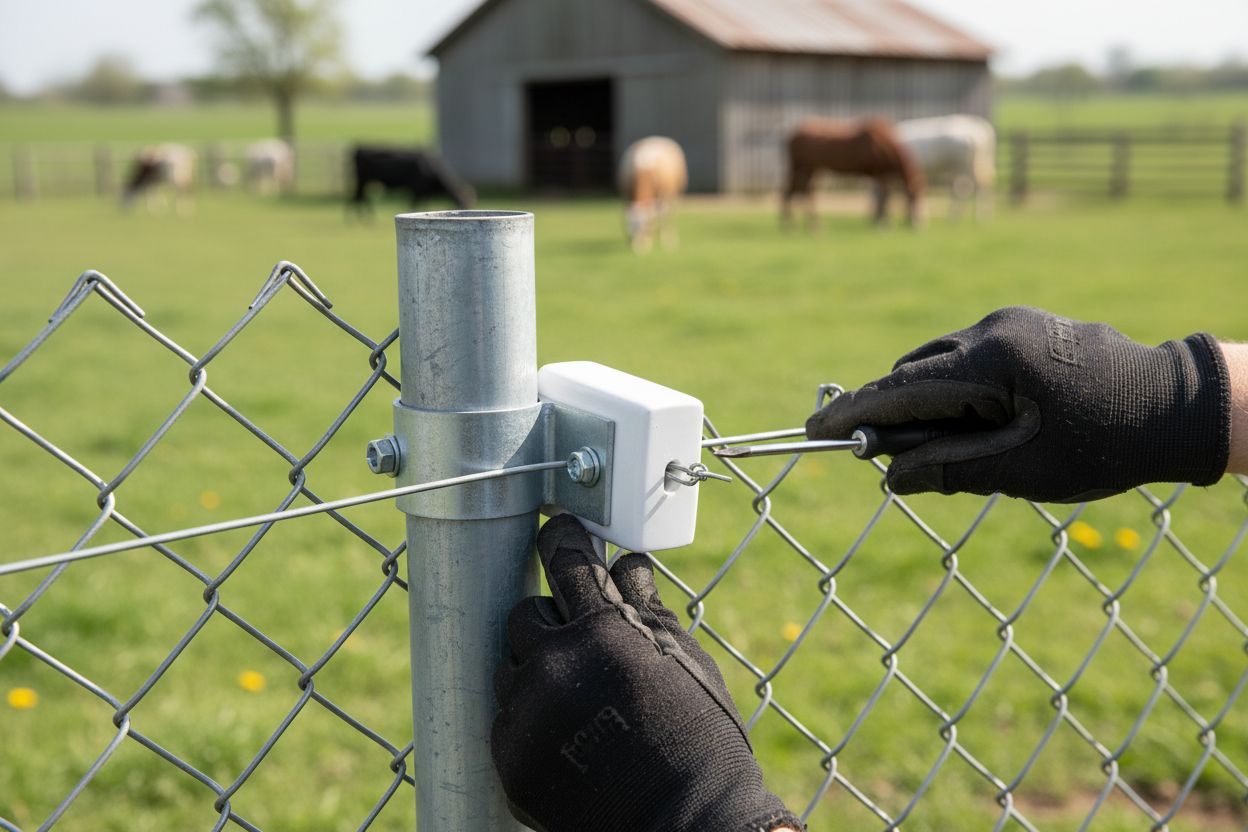Did you know that over 75 percent of electric fence failures on metal fences can be traced to improper insulation? Keeping livestock secure and predators out depends on more than just a charged wire. Choosing the right chain link electric fence insulators helps turn a standard metal fence into a safe, effective barrier, while avoiding shorts and electrical hazards that threaten your animals and property.
Key Takeaways
| Point | Details |
|---|---|
| Electric Fence Insulators are Essential | Chain link electric fence insulators are crucial for safely electrifying metal fences, preventing electrical short circuits and maintaining fence integrity. |
| Variety of Insulator Types | Different insulator types (stand-off, ceramic, polymer, heavy-duty) cater to specific fencing and environmental needs, ensuring optimal livestock containment. |
| Proper Installation is Key | Successful electrification requires a 3-4 inch offset, robust mounting hardware, and attention to grounding and wire routing to maintain effectiveness. |
| Regular Maintenance and Troubleshooting | Inspect and clean insulators regularly to prevent voltage leakage and ensure the longevity of the electric fence system. |
Table of Contents
- What Are Chain Link Electric Fence Insulators
- Types Of Insulators For Chain Link Fencing
- How Electric Fence Insulators Function
- Installation Requirements And Best Practices
- Common Mistakes And Troubleshooting Tips
- Comparing Insulators With Alternative Solutions
What Are Chain Link Electric Fence Insulators
Chain link electric fence insulators are specialized components designed to safely electrify perimeter fencing without compromising the structural integrity of your existing metal fence. Electrical insulators play a critical role in transforming a standard chain link fence into an effective livestock containment and predator deterrent system.
According to research from Top Rail Fences, chain link fences cannot be directly electrified due to their conductive metal nature. These insulators solve that problem by creating a strategic separation between the live electric wire and the metal fence components, preventing dangerous electrical short circuits. The insulators are typically installed using offset brackets that hold the electrified wire parallel to the fence, ensuring a safe and controlled electrical boundary.
The key functions of chain link electric fence insulators include:
- Preventing electrical leakage into the ground
- Maintaining a consistent electrical charge across the fence line
- Protecting metal fence components from corrosion and electrical damage
- Providing a smooth, dry surface to minimize moisture-related electrical arcing
Check out our guide on electric fence post insulators for more detailed insights into selecting the right insulators for your specific fencing needs.
Types of Insulators for Chain Link Fencing
Chain link electric fence insulators come in several specialized designs, each engineered to address specific fencing requirements and environmental challenges. Understanding these variations helps farmers and property owners select the most appropriate solution for their specific livestock containment or perimeter security needs.
According to Margos Supplies, stand-off insulators are one of the most versatile and practical options for chain link fencing. These robust insulators are crafted from UV-resistant plastic and designed to hold electric wire approximately 3½ inches away from the existing fence structure. Their key advantages include:
Here’s a comparison of the main types of chain link electric fence insulators and their features:
![]()
| Insulator Type | Key Features | Best Use Cases |
|---|---|---|
| Stand-Off (Plastic) | UV-resistant Easy to install 3-4 inch offset |
General use Multiple wire types |
| Ceramic | High resistance Long lifespan |
High voltage Wet conditions |
| Polymer Strain | Lightweight Flexible Corrosion resistant |
Uneven terrain Light fencing |
| Heavy-Duty Corner | Manages tension Rugged build |
Fence corners Wire turns |
- Compatibility with multiple wire types (polywire, steel wire, rope)
- Easy installation process
- Durable construction that withstands outdoor conditions
- Flexible positioning for different fence configurations
Beyond stand-off insulators, property owners can also choose from alternative insulator types such as:
- Ceramic Insulators: Traditional option with excellent electrical resistance
- Polymer Strain Insulators: Lightweight and flexible for uneven terrain
- Heavy-Duty Corner Insulators: Designed for managing tension at fence corners and turns
Learn more about livestock fencing strategies to complement your electric fence insulator selection and create a comprehensive perimeter management system.
How Electric Fence Insulators Function
Electric fence insulators are critical components that act as electrical barriers, ensuring that high-voltage pulses remain precisely where they’re intended. Think of them like traffic controllers for electrical energy, strategically preventing unwanted electrical leakage and maintaining the fence’s intended circuit.
According to Wikipedia’s electric fence research, electric fences operate by sending high-voltage pulses through a live wire. Insulator functionality centers on blocking electrical conductivity between the energized wire and supporting structures. This prevents energy from dissipating unnecessarily and ensures that the electrical pulse travels exactly where it should.
The core mechanisms of electric fence insulators include:
- Blocking direct contact between live wires and conductive posts
- Creating a smooth, dry surface that minimizes moisture-related electrical interference
- Directing electrical energy along the intended path
- Reducing potential energy loss through unintended conduction
Rappa’s electric fencing guide highlights that quality insulators are essential for maintaining the fence’s electrical integrity. By providing a non-conductive barrier, these components ensure that the electrical circuit completes through ground rods, creating a controlled and predictable electrical boundary for livestock management and perimeter security.
Installation Requirements and Best Practices
Successful installation of chain link electric fence insulators demands precision and careful planning. The goal is to create a secure, effective electrical boundary that protects your livestock and property while maintaining the structural integrity of your existing fencing.
According to Top Rail Fences, electrifying a chain-link fence requires strategic use of offset brackets or insulators to maintain a safe clearance between the live wire and metal fence components. Mounting materials like pipes or angle iron can be bolted to brace bands, providing a robust and stable platform for securing the electrified wire.
Key installation best practices include:
- Maintaining a consistent 3-4 inch offset from the existing fence
- Using heavy-duty mounting hardware compatible with various post diameters
- Ensuring smooth, unobstructed wire routing

- Checking for potential electrical interference points
- Verifying proper grounding of the entire system
Understanding electric fence basics can further enhance your installation approach. As Margos Supplies highlights, stand-off insulators are designed to accommodate posts and gates up to 2 inches in diameter, offering flexibility and reliability in various fencing configurations.
Common Mistakes and Troubleshooting Tips
Electric fence insulators can fail silently, compromising your entire fencing system’s effectiveness. Understanding potential issues helps prevent livestock escapes and maintains your perimeter’s security. Proactive maintenance is always cheaper than reactive repair.
According to FarmStand’s electric fencing troubleshooting guide, damaged or dirty insulators are primary culprits in voltage leakage. Insulator integrity is critical - cracked, UV-brittle, or contaminated components can significantly reduce fence performance. Moisture accumulation in insulator grooves creates power loss pathways that render your electric fence ineffective.
Common troubleshooting strategies include:
- Regularly inspecting insulators for visible damage or degradation
- Cleaning insulators to remove dirt, dust, and moisture buildup
- Checking voltage levels with a reliable electric fence tester
- Replacing worn or damaged insulators immediately
- Ensuring proper material selection for your specific environment
Understanding electric fence basics becomes crucial when addressing technical challenges. The research emphasizes selecting insulators rated approximately 25% higher than your system’s voltage to prevent electrical breakdown. Porcelain insulators typically outperform plastic in high-voltage scenarios, offering greater longevity and resistance to environmental stress.
Comparing Insulators With Alternative Solutions
Electric fence solutions vary widely, with each approach offering unique advantages and limitations for agricultural and rural property management. Understanding the nuanced differences between dedicated insulators and alternative mounting techniques helps property owners make informed decisions about their perimeter security.
According to Top Rail Fences, one alternative to specialized insulators involves installing electric wire in parallel using offset structures like pipe or angle iron brackets. Alternative mounting methods provide physical wire separation but often lack the sophisticated electrical engineering of purpose-built insulators.
Key comparison points between insulators and alternative solutions include:
- Electrical efficiency and voltage retention
- Installation complexity
- Long-term durability
- Material cost
- Adaptability to different fence configurations
- Resistance to environmental degradation
Learn more about livestock fencing strategies to understand how specialized components can dramatically improve your fencing system’s performance. While improvised solutions might seem cost-effective initially, dedicated insulators ultimately provide superior electrical management, consistent performance, and reduced maintenance requirements.
Secure Your Chain Link Fence With the Right Insulators – Shop FenceFast Today
Tired of voltage drop, short circuits, or escaping animals because your chain link fence cannot hold a charge? If the article made it clear how essential reliable chain link electric fence insulators are in preventing electrical leakage and keeping your fencing system effective, you are not alone. These small components can make or break your perimeter security, especially when dealing with livestock and wildlife challenges. The difference between a safe, functioning fence and a costly breakdown often comes down to the insulators you choose.

Take charge of your fencing with products that are made for Canadian conditions. At FenceFast.ca, you will find electric fence insulators, essential accessories, and expert advice all in one place. Act now to choose high-quality insulators that match your chain link system and protect your farm investment. Looking for more ideas on creating livestock-proof boundaries or want to upgrade your electric fence? Start exploring our site today. Every order is backed by our commitment to fast nationwide shipping and real agricultural expertise. Browse FenceFast.ca and get the components you need to build a trouble-free fence for years to come. For more tips on installation and best fencing strategies, be sure to read this guide on electric fence post insulators or find your best fit among the essential types of livestock fencing.
Frequently Asked Questions
What are chain link electric fence insulators?
Chain link electric fence insulators are components that enable you to electrify a chain link fence safely by preventing electrical contact between the electric wire and the metal fence. They help create an effective containment system for livestock and act as a predator deterrent.
How do electric fence insulators function?
Electric fence insulators block electrical conductivity between the live wire and the metal fence, preventing energy loss. They direct the electrical energy along the intended path while ensuring there is no unwanted electrical leakage.
What are the different types of insulators for chain link fencing?
The main types of insulators include stand-off insulators (UV-resistant plastic), ceramic insulators (high resistance for wet conditions), polymer strain insulators (lightweight and flexible), and heavy-duty corner insulators (designed to manage tension at corners).
What are common mistakes to avoid when installing chain link electric fence insulators?
Common mistakes include failing to maintain a proper offset from the fence, using incompatible mounting hardware, neglecting to inspect insulators regularly for damage, and not ensuring proper grounding of the fence system.
